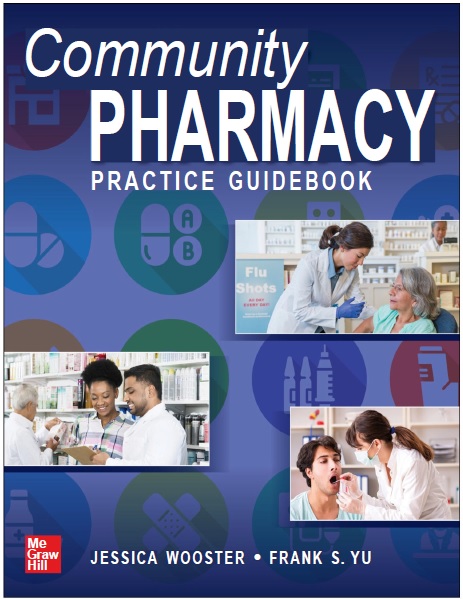Community Pharmacy Practice Guidebook
By Jessica Wooster and Frank S. YU.

Contents:
Contributors
Preface
Chapter 1 Community Pharmacy Practice and Pharmacy Design Models
Jeffrey Hamper, PharmD, BCACP, and Robert Willis, PharmD, BCACP
Chapter 2 Entrepreneurship and Intrapreneurship
Kenneth C. Hohmeier, PharmD, and Raj Chhadua, PharmD, RPh
Chapter 3 Human Resources Management
Jennifer Konieczny, PharmD, Megan Rhyne, PharmD, and Michelle Jeon, PharmD, BCACP
Chapter 4 Optimizing Pharmacy Workflow
Mark Comfort, PharmD, and Nathan D. Pope, PharmD, BCACP, FACA
Chapter 5 Common Legal Aspects of Pharmacy Practice
Rachel E. Barenie, PharmD, JD, MPH, Carol A. Schwab, JD, LLM, and Tyler Dinkelaker, PharmD, JD, MBA
Chapter 6 Pharmacy Inventory
Jeremy Ashley, PharmD, and Mark Sullivan, BPharm
Chapter 7 Role of Technology in Community Pharmacy
Lance Thompson, PharmD, Vanessa Brown, PharmD, and Will Douglas, PharmD
Chapter 8 Profit, Loss, and Risk Management
Kenneth C. Hohmeier, PharmD, and Donald C. Hohmeier, CPA-Retired
Chapter 9 Payment Models and Methods
Jay Bueche, RPh, and Rannon Ching, PharmD
Chapter 10 Quality Metrics
Chelsea P. Renfro, PharmD, James Cong, PharmD, and Benjamin Y. Urick, PharmD
Chapter 11 Clinical and Value-Based Services
Angelina Tucker, PharmD, BCGP, and Roxane L. Took, PharmD, BCACP
Chapter Application Solutions
Index
Preface:
Greetings, pharmacy students, preceptors, and faculty. This textbook, or more appropriately, guidebook, was created to fill an unmet need in the Doctor of Pharmacy curricula. While a significant portion of didactic curricula relevant to community pharmacy includes topics such as communication, pharmacotherapy, self-care, and other patient care skills, other non-clinical facets of community pharmacy practice may be missing. Based on feedback from pharmacists and faculty nationwide, community pharmacy topics such as human resource management, workflow optimization, implementing value-based clinical services, and other practice-based topics are typically covered in either electives or experiential education, if at all.
The goal of our guidebook is to introduce learners to content relevant to community pharmacy practice in the didactic setting. While this is not meant to replace any of the existing textbooks currently in use, we hope that it will serve in a standalone or complementary capacity in the curriculum. This text is intended for pharmacy students prior to embarking on their community pharmacy Introductory Pharmacy Practice Experiences (IPPE), giving them a practical understanding of different responsibilities of the community pharmacist. This text can also be used by community pharmacy preceptors on either IPPE or Advanced Pharmacy Practice Experiences (APPE) to serve as a foundation for topic discussions and other learning activities.
Students and community pharmacy preceptors frequently comment that what is taught in the classroom does not mirror what occurs in real life. For this reason, each chapter of this guidebook intentionally includes authors who are full-time community pharmacists, pharmacy practice faculty, and experts in the content area (e.g. CPA and attorneys). This was done to provide learners with practical, real-life content relevant to what they need to know in community pharmacy practice, in a format that can be used in the classroom or experiential setting. We believe that you will find this guidebook relevant, concise, and practical.
